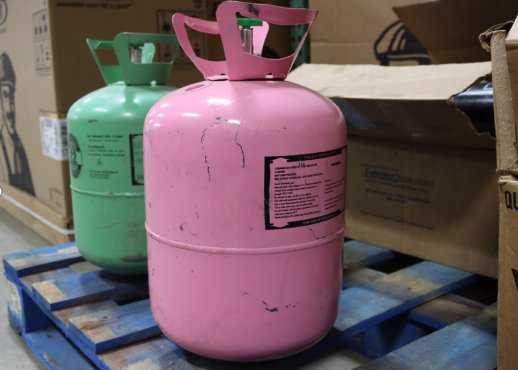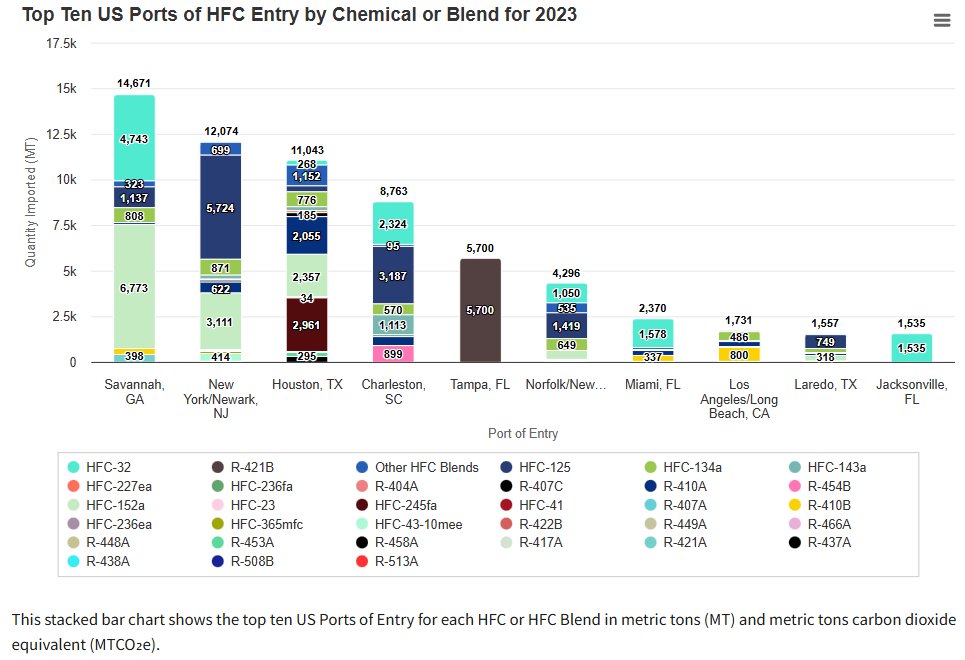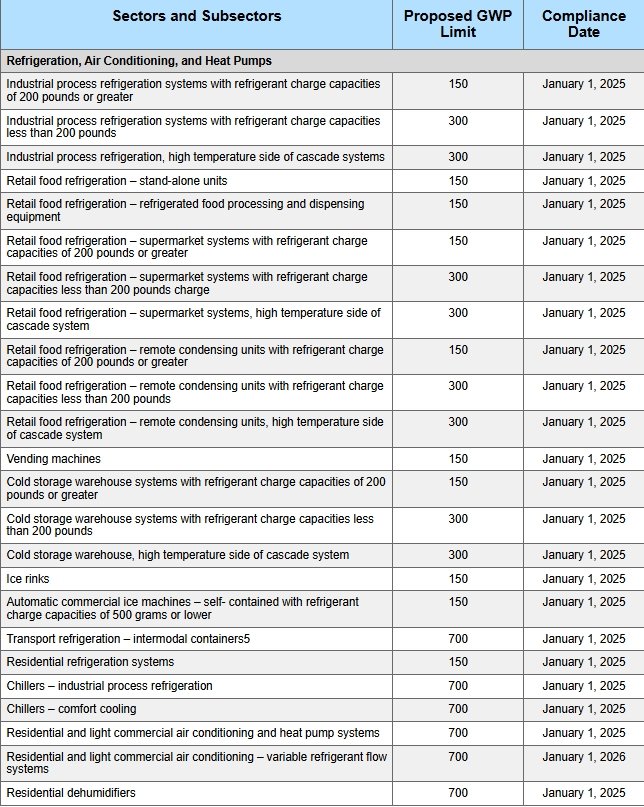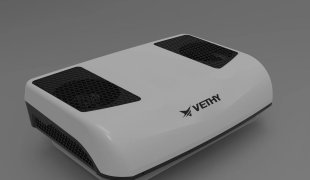R410A is phased out Vethy launches NEW R32 product
January 08, 2024
Vethy R32 Parking Air Conditioning Innovation

The U.S. Environmental Protection Agency (EPA) has officially released the latest regulations for high-GWP refrigerants, and requires all newly produced air-conditioning equipment to gradually phase out high-GWP refrigerants such as R410A and R134A, and switch to more environmentally friendly low-GWP alternatives. Vethy responded quickly to this policy and launched a technological innovation for parking air-conditioning products, focusing on introducing R32 as an alternative refrigerant and optimizing product performance to ensure compliance with future market demand and regulatory requirements.
1. Vethy's technical adaptation of R32 refrigerant
Vethy is well aware of the importance of R32 refrigerant to its parking air-conditioning products. Therefore, after the release of the new EPA regulations, the company immediately invested a lot of resources in technical adjustments.
In actual applications, the molecular structure of R32 is similar to that of R410A, but its thermodynamic properties are superior, especially in terms of heat exchange efficiency and refrigeration efficiency. Vethy optimizes the refrigeration cycle to enable R32 to achieve a seamless transition in compatibility with existing systems and greatly improve refrigeration efficiency. Specifically, through the use of R32, Vethy's parking air conditioning products have improved their energy efficiency ratio (EER) by more than 15%. This means that at the same current, the air conditioning system using R32 can provide more cooling while reducing energy consumption, thereby extending battery life and meeting the needs of long-term parking cooling.
2. R32 and parking air conditioning performance improvement
After introducing R32, Vethy not only replaced the refrigerant, but also improved product performance through a series of technical improvements. First, R32 has a higher cooling efficiency than R410A and can provide the same or stronger cooling effect at a lower compression ratio. After experimental testing, Vethy's new generation of R32 parking air conditioners has an 18% improvement in cooling effect and a 15% reduction in power consumption compared to the old version using R410A under 24-hour uninterrupted working conditions.
In addition, R32 has a higher thermal conductivity than R410A, which means that its heat exchange process is more efficient, allowing the refrigeration system to reach the set temperature in a shorter time, shortening the cooling time after the air conditioner is started. This feature is particularly suitable for parking air conditioners, especially when the car is parked for a long time, the rapid cooling can provide a more comfortable environment for the driver.
3. Machine improvement and product design optimization
In the process of R32 application, Vethy not only focused on the improvement of cooling effect, but also made a number of improvements to the overall design of air conditioning equipment. First, due to the low molecular weight of R32, it requires lower pressure during evaporation and condensation than R410A. To this end, Vethy optimized core components such as compressors and evaporators, reducing the working pressure of the system and improving the stability and durability of the system. Through the improvement of the compressor design, the working life of the new R32 parking air conditioning system has been increased by 20%, and the operating noise of the system has been reduced by 5 decibels, making the overall user experience quieter and more comfortable.
Secondly, the internal pipe layout of the air conditioner has also been optimized to reduce the leakage and loss of refrigerant, improve the sealing of the system and the utilization efficiency of the refrigerant.
4. Compliance with global environmental regulations
When improving its products, Vethy always adheres to the requirements of global environmental regulations to ensure that its parking air conditioners can be sold and used smoothly in different regions. The application of R32 not only complies with the latest EPA regulations, but also complies with the requirements of European F-Gas regulations, helping Vethy's products enter the global market, especially in Europe, North America and South America.
According to feedback from Vethy's technical R&D team, the overall carbon emissions of parking air conditioners have been reduced by about 30% after using R32. This data is due to the low GWP characteristics of R32 itself and Vethy's series of energy-saving designs in system optimization. These improvements have made Vethy's products outstanding in environmental protection and further enhanced its competitiveness in the global market.
5. Testing and Verification: Ensuring Performance and Safety
In the application of R32, Vethy attaches great importance to the testing and verification of new products. In September 2024, Vethy completed all product tests for VS01, VS02, VS02 PRO and backpack parking air conditioners to ensure that these products have not only improved performance but also higher safety after using R32.
Test data show that the parking air conditioning system using R32 can still maintain a stable cooling effect under extreme conditions (such as high temperature and high humidity), and there is no leakage or system failure during long-term continuous operation. Vethy pays special attention to the slight flammability problem of R32, and ensures the safety of R32 during operation by improving the system sealing and adding intelligent safety detection devices. All tests show that Vethy's new products have reached the industry-leading level in terms of safety, environmental protection and performance.
6. Market Prospects and Outlook
Vethy's technical improvements based on the new EPA regulations have not only improved its product competitiveness in terms of environmental protection and energy efficiency, but also won wide recognition in the market. As more and more countries and regions begin to implement refrigerant regulations similar to those of the US EPA, the application of R32 as a low GWP refrigerant will surely become a trend in the development of the industry. With its deep understanding and innovative application of R32 refrigerant technology, Vethy will continue to lead the parking air conditioning industry towards a more environmentally friendly, efficient and safe direction.

TABLE : This stacked bar chart shows the top ten US Ports of Entry for each HFC or HFC Blend in metric tons (MT) and metric tons carbon dioxide equivalent (MTCO₂e).
Why R32 is imperative?
Recently, the Environmental Protection Agency (EPA) released a proposed rulemaking detailing how it plans to ban the use of many HFCs in new air conditioners and commercial refrigeration equipment. The rulemaking is part of the AIM Act, which tasks EPA with phasing down the production and consumption of HFCs by 85% by 2036; maximizing refrigerant reclamation and reducing leaks; and restricting the use of regulated HFCs in sectors or subsectors where they are used. This rulemaking addresses the third area, specifically, transitioning to alternatives through sector-based restrictions.
In the proposed rule, all restrictions would occur in two stages: The manufacture or import of products would be prohibited by either 2025 or 2026, depending on the sector or subsector, followed a year later by a prohibition on the sale, distribution, offer for sale or distribution, export, and other activities pertaining to those products (see Tables 1 and 2). This proposed rulemaking addresses all petitions that EPA has granted thus far.
TABLE 1: Proposed GWP limit restrictions on HFCs by sector and subsector. (Courtesy of EPA)

TABLE 2: Proposed prohibited substance restrictions on HFCs by sector and subsector. (Courtesy of EPA)

While most thought that EPA would follow California’s lead and propose a 750 GWP limit in new air conditioners and heat pumps, the Agency’s rulemaking calls for a 700 GWP limit for most new comfort cooling equipment, including chillers, starting January 1, 2025. VRF systems would have until January 1, 2026 to comply with the restrictions. The rule also proposes a 150 or 300 GWP limit for most new commercial refrigeration equipment used in supermarkets and convenience stores, also starting in 2025.
To support compliance with the proposed prohibitions on the use of HFCs in specific sectors and subsectors, EPA is proposing labeling, reporting, and recordkeeping requirements for products imported or manufactured using an HFC. The Agency is proposing to use the same reporting platform used in prior AIM Act rules and the Greenhouse Gas Reporting Program (GHGRP).
EPA estimates that the proposed rule, if finalized as written, would result in significant greenhouse gas (GHG) emissions reductions benefits while providing savings to American consumers and industry through energy efficiency gains and lower cost alternatives. The proposal would result in cumulative GHG emissions reductions ranging from 134 to 903 MMTCO2e through 2050. EPA estimates that the cumulative net benefits of this proposed action are between $13.1 billion to $56.3 billion from 2025 through 2050.
EPA will accept comments on this proposal for 45 days after publication in the Federal Register and will hold a virtual public hearing after publication in the Federal Register. For more information on the rule and how to comment, as well as information on the virtual public hearing, please visit www.epa.gov/climate-hfcs-reduction.
KEYWORDS: AIM (American Innovation and Manufacturing) ActEPA regulationsgreenhouse gasHFC refrigerantsRefrigerant Phasedown
Background and Purpose of the Ban
The EPA's ban on high-GWP refrigerants aligns with the Clean Air Act and the international Montreal Protocol, aiming to protect the ozone layer and mitigate climate change. These policies focus on phasing out hydrofluorocarbons (HFCs), which have been shown to contribute significantly to global warming. The agency’s actions are consistent with the American Innovation and Manufacturing (AIM) Act, under which the U.S. is committed to reducing HFC consumption by 85% by 2036
Ban Details and Timeline
The phasedown and eventual ban on refrigerants like R134a and R410A will be implemented gradually to allow industries to transition smoothly. Key aspects include:
1.Chillers: Starting January 1, 2025, chillers will be restricted to refrigerants with a GWP of 700 or below. This limits the use of R134a and R410A, which exceed this GWP limit, thereby making them unsuitable for new chillers.
2.Residential and Light Commercial Air Conditioners and Heat Pumps: Similar to chillers, these systems will also face a GWP cap of 700 from January 1, 2025. This effectively phases out R410A and R134a in favor of more environmentally friendly alternatives such as R32, which has a GWP of 675 and better aligns with these requirements.
Additionally, earlier regulations already banned high-GWP refrigerants in certain applications, including:
R404A and R507A: Prohibited in new food retail refrigeration equipment since January 1, 2021, and in new cold storage equipment as of January 1, 2023.
R134a in Household Refrigeration: Banned since January 1, 2021, and in new centrifugal and reciprocating chillers as of January 1, 2024
Compared with R32 and R410A, what are the advantages for parking air conditioners?
Compared with R410A, R32 has the following significant advantages in parking air conditioning systems:
1. Higher energy efficiency ratio: The thermodynamic properties of R32 are superior, which means that under the same cooling capacity, the R32 system has a higher energy efficiency ratio. For example, Vethy found in factory product update tests that the energy efficiency ratio of parking air conditioning systems using R32 refrigerant was improved by about 10% compared to R410A systems, which helps reduce energy consumption and improve energy efficiency.
2. Lower global warming potential: The global warming potential (GWP) of R32 is much lower than R410A, which means it has less impact on the environment. According to the evaluation of international environmental protection organizations, the GWP value of R32 is about 1/3 of R410A. Therefore, the parking air conditioning system using R32 can help reduce greenhouse gas emissions and is more in line with current environmental protection policies.
3. Better fluidity: R32 has better fluidity, which helps improve the cooling efficiency of the air conditioning system. In the parking air conditioning system, R32 can transfer heat faster, thereby achieving faster cooling effect.
4. Lower charging volume: Due to the higher cooling efficiency of R32, less charging volume is required for the same cooling capacity. This helps reduce the cost of the air conditioning system and reduces refrigerant usage.
5. Lower toxicity: R32 has lower toxicity than R410A, so it has certain advantages in terms of safety. In parking air conditioning systems, the use of R32 can reduce the potential threat to human health caused by refrigerant leakage. After a logistics company adopted R32 parking air conditioners, employees reported that the air conditioning system operates more safely and reliably, reducing health problems caused by refrigerant leakage.
To sum up, R32 has many advantages in parking air conditioning systems, including higher energy efficiency, lower global warming potential, better mobility, lower filling volume, better compatibility and Lower toxicity. These advantages make R32 an ideal refrigerant for parking air conditioning systems.
Parking air conditioning industry responds and turns to R32
In response to EPA's requirements, Vethy Industries immediately began adjusting its product line to accommodate low-GWP refrigerants such as R32 after seeing the news on October 1, 2024. Since the working pressure characteristics of R32 are different from R410A, the compressor, piping, and system design will be different. At present, all air conditioning products of Vethy Industries have been upgraded.
The future of R32 and other considerations
R32 is not only a regulatory-compliant choice, but also a cost-effective and operationally efficient solution. Although it is slightly flammable, it is safe to handle it under appropriate industry standards, and the HVAC industry has largely developed protocols to ensure the safe use of R32. For companies like Vethy, this transition also involves extensive testing and compliance verification to meet EPA standards and international safety certifications.
Specific feasibility of R32
1. Promotion of environmental protection policies
Major countries and regions around the world have begun to phase out high-GWP refrigerants to reduce the impact on the climate. The Kigali Amendment to the Montreal Protocol further included HFCs in the control, forcing countries to accelerate the elimination of high-GWP refrigerants such as R410A and R134a. Under the AIM Act, the US Environmental Protection Agency (EPA) clearly requires that refrigerants with a GWP value of more than 700 be banned from residential and commercial air-conditioning equipment starting in 2025. Therefore, R410A (GWP value 2088) will no longer meet the requirements, and R32 (GWP value 675) will become a reasonable choice.
In addition, the F-Gas regulations adopted by the European Union also promoted the elimination of high-GWP refrigerants. The regulations stipulate a 79% reduction in HFC use by 2030. Since parking air-conditioning equipment needs to run continuously for a long time, its environmental impact is greater than that of ordinary air-conditioning. The use of low-GWP R32 helps to meet the requirements of future regulations while reducing its contribution to global warming.
2. Comparison: GWP Difference and Environmental Impact between R32 and R410A
GWP is a key indicator to measure the potential of greenhouse effect. The GWP value of R410A is as high as 2088, while the GWP value of R32 is significantly reduced to 675. In short, the greenhouse effect of R32 is only one-third of that of R410A, which means that for every unit of R32 released, the impact on the climate is only about 33% of the same amount of R410A. Therefore, the burden on the environment of parking air conditioning products using R32 refrigerant is significantly reduced in daily operation, which is crucial for global climate protection. Efficiency performance: R32's high efficiency characteristics
Compared with traditional refrigerants, R32 has a significant advantage in refrigeration efficiency. Data shows that the energy efficiency ratio (EER) of R32 refrigerant is about 10-15% higher than that of R410A. The higher the EER, the more cooling capacity is generated per unit of electricity, thereby improving the energy efficiency performance of the air conditioning system. For parking air conditioning equipment, this means that a longer-lasting and stable cooling effect can be provided at the same power consumption. For example, when parking for a long time in the summer, the high efficiency advantage of R32 refrigerant can help extend battery life and reduce the need for frequent charging, thereby reducing operating costs.
According to refrigeration engineering, R32 has a higher capacity and thermal conductivity than R410A, which enables R32 to achieve more efficient heat exchange in a smaller compressor and evaporator volume, further improving the space utilization and cooling efficiency of parking air conditioning equipment. This high efficiency makes R32 particularly suitable for vehicle air conditioning equipment with high requirements for cooling performance and compactness, such as trucks and RVs.
4. Safety considerations:
R32 has a certain degree of slight flammability (A2L level), but there are many mature safety application solutions to manage this risk. By setting up safety measures such as leak monitoring and spark control, R32 has been proven to be safe and controllable in actual operation. In fact, R32 has been widely used in the air conditioning market in Japan, Australia and Europe, and has obtained positive feedback on safe use.
In addition, since the compression ratio of R32 is lower than that of R410A, this means that in the air conditioning system using R32 refrigerant, the operating pressure of the equipment is relatively low. The low-pressure system not only reduces the wear of the compressor and other system components, but also significantly reduces the safety hazards caused by high pressure.
5.Market acceptance and technical maturity
In the international market, the brand's refrigerant is the first choice. For example, Mitsubishi Electric, Panasonic, Fujitsu and other companies have launched commercial and household air-conditioning products with R32 as the refrigerant, and its performance has been widely recognized in terms of energy saving, environmental protection and safety. The US market has also begun to gradually accept R32 under the promotion of EPA, and many parking air-conditioning manufacturers have begun to apply R32 to product design to ensure compliance with regulations and market demand in the next few years.
From the perspective of technical maturity, the hardware technology required for the R32 system is relatively economical in production cost, and can be adjusted on the basis of existing R410A equipment, which makes it easier for parking air-conditioning manufacturers to upgrade R32 technology. Many industry studies have shown that R32 has higher refrigeration efficiency and system compatibility, and can effectively reduce the size and weight of the equipment, which is the key to improving the flexibility and market competitiveness of parking air-conditioning equipment.
VI. Overview:
Comprehensive advantages of R32 in parking air conditioners
R32's low GWP value in the field of parking air conditioners meets the requirements of global environmental regulations, and its excellent energy efficiency performance can reduce power consumption and bring users longer cooling time. At the same time, after sufficient safety management, R32's application practice has accumulated rich experience worldwide, laying the foundation for its widespread promotion in the field of parking air conditioners.
Overall, with the global gradual elimination of high-GWP refrigerants, R32 will become the mainstream choice in the parking air conditioner market. Its advantages in environmental protection, energy saving, design adaptability and safety have injected new technical power and market competitiveness into parking air conditioner products. In this context, the research and development and production activities of innovative companies such as Vethy will further promote the global popularity of R32 parking air conditioners and become an important solution for the industry to cope with environmental protection and energy saving challenges.





